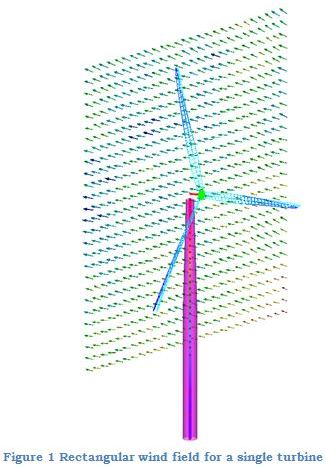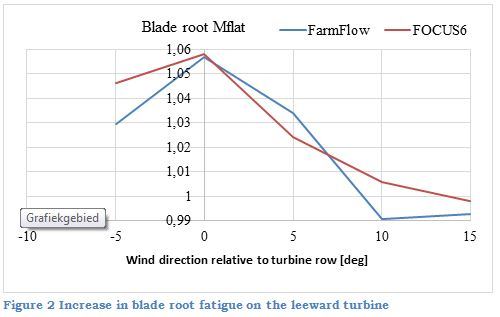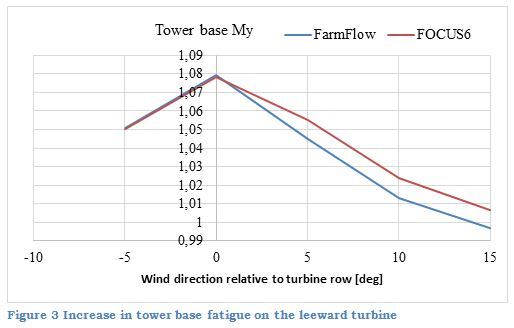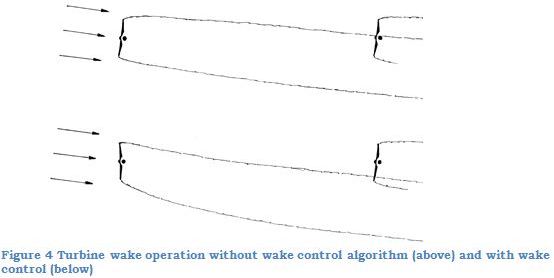
◀ Back to projects overview P201406_003_WMC
Simulation of Wind Farm Aerodynamics
Public summary
Most of the wind energy worldwide is generated by wind turbines in a wind farm. Still the wind turbine design standards describe wind loading without wake effects of neighbouring turbines. In the conventional IEC 61400-1 ed.3 design standard the effects of operation in a wind farm are included in Annex D that contains a description of increased turbulence. Last year, research is done into more detailed engineering descriptions of wind conditions in a wind farm, resulting in the so-called ‘Dynamic Wake Meandering’ model. This model is still proposed for the next edition of the IEC 61400-1 design requirements. In the underlying project ‘Simulation of Wind Farm Aerodynamics’ a program is developed for the design of wind turbines including the wake effects of an upstream turbine.
Objectives
The main objective of the present project was to improve the structural reliability of wind turbines by providing a more complete design tool for power optimisation and loads reduction of a wind farm aiming at a reduction of the cost of energy of wind farms. This was realised by developing an integrated engineering design tool for fatigue load calculation of wind turbines in a wind farm, and for development and evaluation of wind turbine controllers that reduce the effect of wind turbine wakes in a wind farm. To this end, the following three objectives have been formulated:
- Create a version of the existing FOCUS6 integrated design package for ‘Farm Wake Wind Turbine Simulation’. This version of FOCUS6 is flexible for implementation and application of different models for the meandering of the wind turbine wakes as well as for the transportation velocity of wind structures in wind direction. -‘meandering’ is the change in lateral position of the wake as it passes another turbine.- This simulation tool still describes the wind turbine dynamics in the same way as for individual wind turbines such that it is valid for certification purposes.
- Gain insight in the transportation of wind structures in wind direction and also in transverse direction, named meandering. In the FOCUS6 module for wind farms the basic ‘default’ algorithm for wake meandering applies to the ‘Dynamic Wake Meandering’ modelling.
- Provide an analysis tool evaluation and optimisation of wake-controlling algorithms such as the ECN-patented ‘Heat and Flux’ and the ‘Controlling Wind’ concept.
Approach and results obtained
For developing a design environment for wind farm wake simulation an engineering approach was chosen based on publications of the Dynamic Wake Meandering (DWM) approach, amongst others by Risø. The DWM approach was chosen because it is also proposed for the follow-up of the IEC 61400-1 ed.3 design requirements. In the DWM approach the wake effects are described by a velocity deficit, a meandering path of the wake and an increased ‘added’ turbulence. In this engineering approach the behaviour of the rotor wake is described in different individual programs, with the aim that each of these programs can be adjusted easily.
For a realistic wind description in a wind farm, a stochastic wind simulator SWIFT-r has been built that can generate turbulent wind fields for a farm-wide rectangular grid, as shown in Figure 1 for a single turbine.
Following the descriptions of the DWM model, these wind fields can describe either the Low-Frequency part or the High-Frequency part of the wind field. It is shown that these wind fields give equivalent wind turbine fatigue loads as the conventional wind fields with a polar grid.
Based on the farm-wide rectangular wind fields and with the tools for meandering and mixing of the rotor wake, a module has been built in the integrated FOCUS6 design package. In the underlying project this was done for 2 wind turbines, one upstream- and one leeward- turbine. The data flow between the different programs was arranged such that it can easily be extended to describe the wake effects of more than 1 upwind located wind turbine.
With the FOCUS6 module two large size wind turbines are modelled in an offshore environment. For these turbines the fatigue loading and power output have been calculated as for a standalone wind turbine, using the wake turbulence model of Frandsen, using the output of the ECN program FarmFlow, and with the models for wake effects that were developed in FOCUS6 during this project. The dynamic response calculated with the newly-developed FOCUS6 tools, and calculated using the FarmFlow interface showed to have wake effects with similar strength and fatigue loading. Figures 2 and 3 show the increase in calculated fatigue loading of a 5MW offshore wind turbine operating in the wake of another turbine at a distance of 7 rotor diameters apart.
Finally, a study was performed into the application of wake controlling algorithms. ECN created a controller with an additional algorithm for wake control by adding an off-set to the yaw angle. As shown in Figure 4, this yaw off-set reduces the amount of wake influence on the leeward turbine.
Implementation of this algorithm and repeating the wind farm wake calculations proved to be easy. However this algorithm showed a very moderate reduction in wake effects, caused by the relatively low rotor disk loading of the wind turbines under consideration.
Contribution to FLOW targets
The wind farm design tool developed in this project is a platform for the development of wind farm wake controllers. This addresses FLOW R&D line 1.1 which states that the new wake knowledge will be used to improve the control of the entire wind farm to maximize power production and minimize turbine loading.
The wind description (velocity and turbulence) in the new design tool is shown to be similar to that following the existing FarmFLOW program for prediction of the power production and fatigue loading of a turbine operating in the wake of another turbine. The time-domain simulation of the wind farm design tool allows to evaluate the time-based effect of the upstream turbine controllers on the wake effects of the leeward turbine. This forms a basis for improvement of wind farm controllers in terms of increasing the power output and reducing the fatigue damage on turbines in a farm.
Optimisation of wind farm wake controllers will yield a further cost reduction in the future. With the fact that the dynamic turbine response is calculated in the same way as needed for the certification purposes, and the fact that the wake description applies to the requirements proposed for the upcoming IEC 61400-1 ed.4 design standards means that the new design tool will reduce the risk of (component-) failure of wind turbines in a wind farm. This reduced risk will reduce the LCoE by a reduced downtime and finally accelerate the deployment of offshore wind energy.
Contact details
Mr. Ben Hendriks





 Share this page
Share this page
